Occasionally, in my personal life, I reflect back on what I was doing 10 years ago, 20 years ago, 30 years ago, etc. Taking a step back to look at the broader picture gives you a different sense of your current situation.
Below is a little collection extracted from the Trombone History Timeline showing some of the things that occurred in trombone history one, two, three, four, and five centuries ago. It’s an interesting perspective.
__________
One Century Ago:
 1917—Horatio Parker, one of the most respected American composers of his time, mentions that using alto trombone rather than tenor results in “a certain transparency, even gracility, in general effect” (Parker 486).
1917—Horatio Parker, one of the most respected American composers of his time, mentions that using alto trombone rather than tenor results in “a certain transparency, even gracility, in general effect” (Parker 486).
1917—Ottorino Respighi, Pines of Rome.
1917—New Orleans, Louisiana: Trombonist Eddy Edwards, performing as a member of the Original Dixieland Jazz Band, participates in the first commercial recordings of what is advertised as jazz. Edwards is considered by some to be the first jazz trombonist to gain national fame (Dietrich 17).
1917—Herb Flemming, one of the few early jazz trombonists not from New Orleans (he was born in Montana but moved to New York as a youth), goes to France with James Reese Europe’s 369th US Infantry Band (the “Hell Fighters’). One of the most internationally active early jazz trombonists, Flemming later tours throughout Europe, South America, and even China. During his time spent in the US, Flemming records with Ethel Waters and trumpeter Johnny Dunn, as well as performing with such legendary band leaders as Earl Hines, Fats Waller, Benny Carter, and Tommy Dorsey (Dietrich 17).
c. 1917—A photo postcard features an elaborately-uniformed trombone player, probably from the Municipal Band of Harrisburg, Pennsylvania (see below image; public domain) (source: temposenzatempo).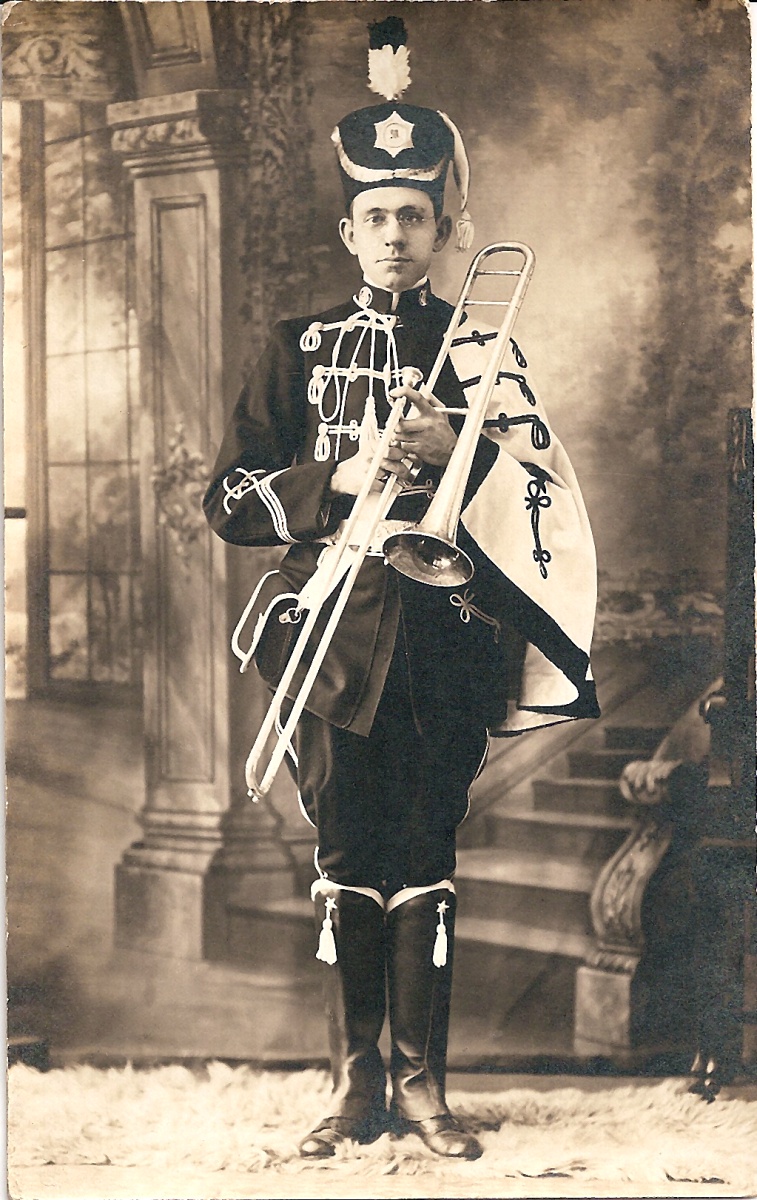
__________
Two Centuries Ago:
1817—Prussia: Prussian Jägr regimental bands have an instrumentation of 2 trombones, 3 horns, 2 keyed bugles, and 2 trumpets as early as 1817 (Dudgeon, Keyed Bugle 166).
1817—Bremen, Germany: The Bremen Town Orchestra contains a single trombone (Herbert, Trombone 333).
1817—London, England: The “Ancient Concerts” include 3 trombones (Herbert, Trombone 333).
1817—Gioacchino Rossini, La Gazza Ladra.
1817—Gottfried Weber designs a complete set of double-slide trombones. Made by Schott of Mainz, these instruments all have 9 slide positions instead of 7 (Carse, Musical 258).
1817—Paris, France: The Theatre Italien orchestra includes 2 trombones (Herbert, Trombone 333).
1817-1818—Bethlehem, Pennsylvania: Sources document a rivalry between 2 different Moravian trombone ensembles, an adult choir and a youth choir (Carter, Trombone Ensembles of the Moravian).
__________
Three Centuries Ago:
1717—Vienna, Austria: Antonio Caldara’s aria, “Quell’amor” from Santa Ferma, features soprano voice and obbligato alto trombone (Carter, Trombone Obbligatos).
1717—Dresden, Germany: the court ensemble includes 8 trombonists (Spagnoli 93).
1717—Sorau, Poland: Georg Philipp Telemann calls for 3 trombones in his Erhöre mich, wenn ich rufe (Collver 178).
__________
Four Centuries Ago:
c. 1617—Antwerp, Belgium: Hendrick van Balen and Jan Brueghel collaborate on a painting called An Allegory of the Five Senses, which includes a trombone among several instruments in the foreground (see below detail; public domain) (Haeften, pl. 8). For other depictions of the trombone by the same painter, see c. 1610 (Banquet of the Gods), c. 1615 (Minerva among the Muses), and c. 1625 (Allegory of Music).
1617—Milan, Italy: Bartolomeo Roverio includes 3 trombones among many angel musicians in a ceiling fresco at San Marco (see 3 details and full image below; public domain) (Perer 172).
1617—Stuttgart, Germany: A festival book with engravings by Esaias von Hulsen, published in 1618, portrays the Stuttgart festivals of 1617 surrounding the christening of Ulrich of Württemberg and the marriage of Ludwig Friedrich of Württemberg to Elisabeth Magdalena of Hesse-Darmstadt. It features two different plates in the procession that include 4 different trombonists, all of them apparently female players (see below 2 images; click on image for larger version; public domain) (sources: Komma 128, Festkultur online).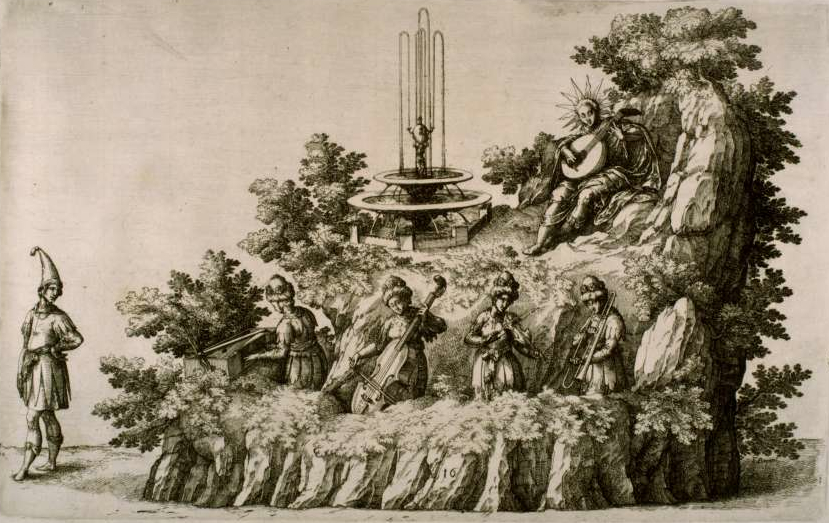
1617—Dresden, Germany: In a letter from Heinrich Schütz to Heinrich Posthumus of Reuss-Gera (Germany), Schütz recommends that 2 boys of the court ensemble be trained on trombone (Spagnoli 69-70).
1617—Dresden, Germany: A 3-day celebration is held to mark the centenary of the start of the Reformation. For the occasion, Heinrich Schütz writes several richly scored Psalm settings that include cornetts, trumpets, trombones, and timpani (Smallman 29).
1617—Venice, Italy: Biagio Marini’s Affetti musicali, a collection of instrumental music, includes several works that specify trombone: La Giustiniana (2 cornetts or violins, trombone, continuo), La Foscarina (2 cornetts or violins, trombone or bassoon, continuo), La Hiacinta (violin or cornett, trombone, continuo), La Marina (cornett or violin, 2 trombones, continuo) (Winkler 299, Collver 45).
1617-1622—Ferrara, Italy: Incoronazione della Vergine, a painting by Carlo Bononi in the basilica di Santa Maria in Vado, includes a lute and what appears to be a trombone (see below image; public domain).
1617-1626—Bologna, Italy: Camillo Cortellini, leader of the Concerto Palatino, publishes numerous concerted masses that include trombone. For example, his Messe a otto voce (1617) includes 3 trombones (Schnoebelen, Bologna 1580, 113; Guion, Missing Link).
1617-1618—Antwerp, Belgium: Jan Brueghel the Elder and Peter Paul Rubens collaborate on a series of paintings on the subject of the 5 senses. The Sense of Hearing or Allegory of Hearing depicts a trombone among the many instruments in the room. All of the paintings in the series are “portrayed against a backdrop of princely collections that together seem to paint an idealized picture of the court of the Habsburg rulers of the Southern Netherlands, the archdukes Albert and Isabella, whose castles in and near Brussels are depicted in the distance” (see facing detail; public domain) (Woollett, 91-92; Museo del Prado, Madrid).
__________
Five Centuries Ago:
1517—In a letter of 1517, Ambassador Tunstall, ambassador for England’s King Henry VIII, claims to have discovered that trombonist Hans Nagel is clearly acting as a double agent. Nagel, who, as a respected musician, had moved freely among nobility throughout Europe, had been hired as a spy by King Henry VIII of England two year earlier, in 1515. King Henry had been particularly concerned about obtaining more information about Richard de la Pole, known as the White Rose. De la Pole, an exiled duke of Suffolk, lived in Metz, France, and apparently had remote claims to the throne. Hans Nagel had agreed to make contact with de la Pole, which he apparently did in the following years. Nagel then apparently developed a close enough relationship with de la Pole that King Henry began to express concern that Nagel had become a double agent. King Henry subsequently called Nagel back to England, but Nagel refused to return without amnesty. Nagel never returned to England (Bouckaert and Schreurs 109).
1517-1519—Rome, Italy: Two paintings by Giovanni da Udine on the colonnade of the Loggia of Raphael in the Vatican include trombone in a trophy (or decorative cluster) of musical instruments representing a shawm band (see below 2 images; public domain) (Myers, Instrument Trophies). The images are badly deteriorated but are also reproduced in the 18th century by Giovanni Volpato (see 18th century timeline).

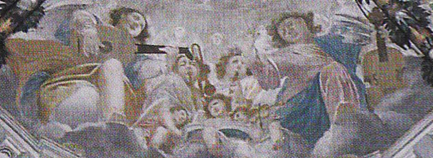

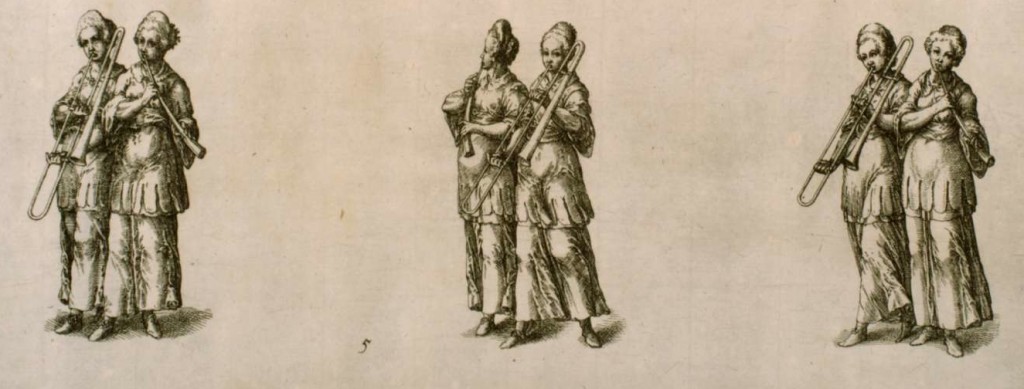
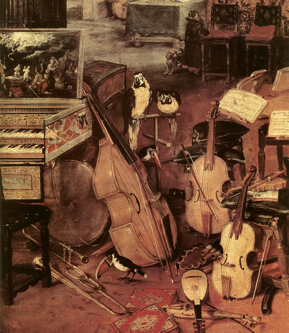
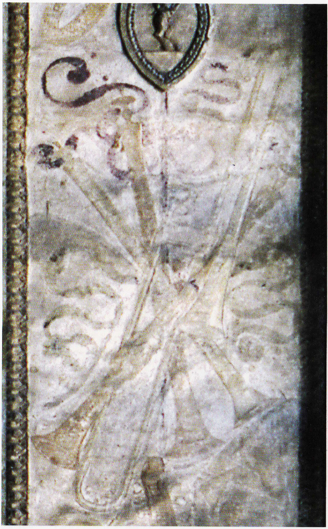
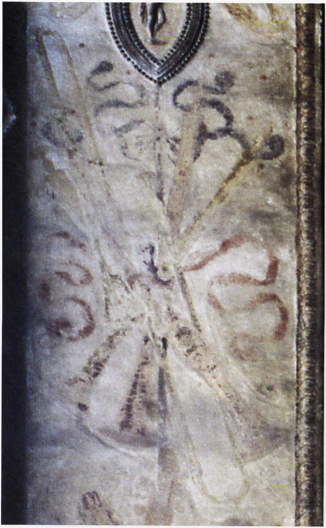
Merrill Perret
Thanks for an interesting and informative article. The (video) musical examples of the period are helpful in understanding the particular styles.
wkimball
Great! I’m glad you liked it.